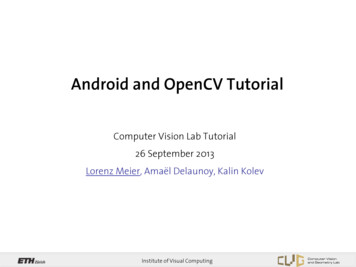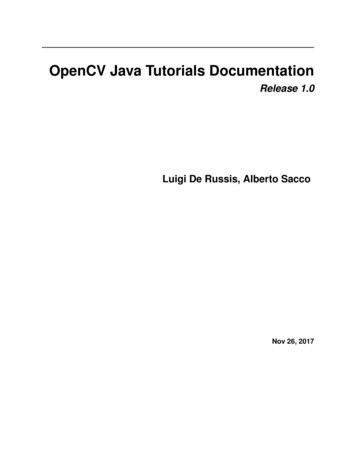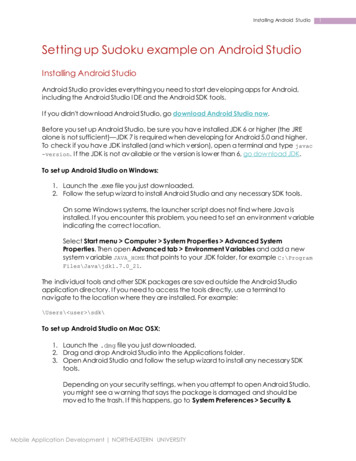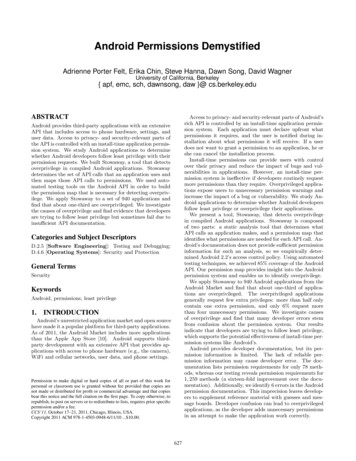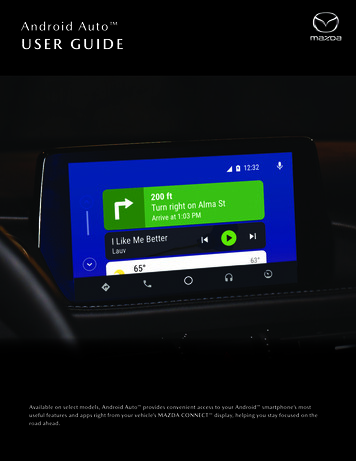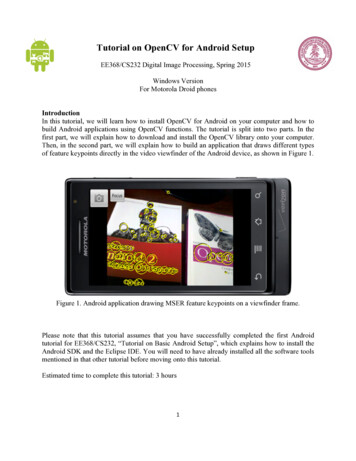
Transcription
Tutorial on OpenCV for Android SetupEE368/CS232 Digital Image Processing, Spring 2015Windows VersionFor Motorola Droid phonesIntroductionIn this tutorial, we will learn how to install OpenCV for Android on your computer and how tobuild Android applications using OpenCV functions. The tutorial is split into two parts. In thefirst part, we will explain how to download and install the OpenCV library onto your computer.Then, in the second part, we will explain how to build an application that draws different typesof feature keypoints directly in the video viewfinder of the Android device, as shown in Figure 1.Figure 1. Android application drawing MSER feature keypoints on a viewfinder frame.Please note that this tutorial assumes that you have successfully completed the first Androidtutorial for EE368/CS232, “Tutorial on Basic Android Setup”, which explains how to install theAndroid SDK and the Eclipse IDE. You will need to have already installed all the software toolsmentioned in that other tutorial before moving onto this tutorial.Estimated time to complete this tutorial: 3 hours1
Part I: Installing OpenCV for Android 1Downloading and Installing CygwinCygwin allows us to execute Linux commands on Windows, which is required for buildingthe OpenCV library.1. We need to install Cygwin on a Windows account without spaces in the name. Forexample, if your account name is “John Doe”, this will cause problems for the subsequentsteps. In that case, create a new account named “JohnDoe” (without spaces) and run allthe following steps on the new account.2. Download the latest installer file from this website:http://cygwin.com/install.html3. Run the downloaded installer file “setup.exe”.4. Choose “Install from Internet”.5. Choose an install location without spaces in the path; we recommend:C:\\cygwin6. Choose a location to store the installation files; we recommend:C:\\cygwin\\local packages7. Choose “Direct Connection” and pick a download site. We found the following site givesa fast response:http://mirrors.xmission.com8. When asked to choose which packages to install, click the looped arrow symbolnextto “All” until the option for every package changes to “Install”, as shown in Figure 2.Then, click “Next”.Figure 2. Selecting packages to install for Cygwin.1Parts of this tutorial borrow explanations from the OpenCV website (opencv.willowgarage.com/wiki/Android).2
9. Make sure “Select required packages” is checked. Now, all the packages will bedownloaded and installed. This process can take a while, maybe 1 hour or more.10. Choose to create a shortcut to the Cygwin terminal on your desktop.11. Some useful tips about working with Cygwin are available here:http://www-cdf.fnal.gov/ cplager/cygwin.htmlDownloading and Installing Tortoise SVNWe need a program that allows us to easily check out SVN repositories. Tortoise SVN is aprogram that integrates nicely into the Windows shell, so you can simply right click andexecute SVN commands from the popup menu. If you already use another SVN tool, feelfree to skip installation of Tortoise SVN.1. Download the program from this website:http://tortoisesvn.net/downloads.html2. Install Tortoise SVN on your computer. You may need to restart your computer.Downloading and Installing Android NDKThe Android NDK enables us to compile and run native C/C code on Android.1. Download “android-ndk-r4-windows-crystax-4.zip” from this . Unzip the downloaded file to your Android directory, for id-ndk-r4-crystaxDownloading and Installing Apache AntWe need Apache Ant to help us build certain Java programs.1. Download the zip file from this website:http://ant.apache.org/bindownload.cgi2. Unzip the downloaded file to a convenient location; we recommend:C:\\apache-ant-1.8.4Downloading and Installing JavaWe need to determine if Java is already installed on the machine.1. Check if “java” is installed by typing in a Cygwin terminal:whichjavaIf installed, the installation path should be printed.2. If “java” is not installed, please visit this site to perform the a/javase/downloads/index.html3
Downloading and Installing OpenCVNow, we are ready to download and install the OpenCV library.1. Download the OpenCV package from this opencv.tar.gzCheck out into a convenient location; for v2. Make sure important programs are in the PATH.a. Find the user’s startup “.bashrc” file, located (for example)C:\\cygwin\\home\\username. Add the following lines to inNDK /home/username/Android/android-ndk-r4-crystaxSDK /cygdrive/c/Android/android-sdk-windowsANT HOME /cygdrive/c/apache-ant-1.8.4OPCV /home/username/Android/opencvJAVA HOME ”/cygdrive/c/Program Files/Java/jdk1.6.0 24”PATH /usr/local/bin:/usr/bin: NDK: SDK/tools: SDK/platform-tools: ANT HOME/bin: JAVA HOME/binBe sure to change the locations above to match the folders where you placed AndroidNDK, Android SDK, Ant, OpenCV, and Java JDK.b. Open a Cygwin terminal and execute this command:source.bashrcc. Execute these commands in the Cygwin terminal and verify they give the desiredoutputs:whichmakeà /usr/bin/makewhich cmakeà /usr/bin/cmakeprintenv NDKà env SDKà v ANT HOMEà /cygdrive/c/apache-ant-1.8.4printenv OPCVà /home/username/Android/opencvprintenv JAVA HOMEà /cygdrive/c/Program Files/Java/jdk1.7.0 03printenv PATHà PATH should contain the following folders:Android NDK, Android SDK, Ant, OpenCV, Java JDKIf the above variables are not set correctly, you will most likely encounter errors inthe subsequent parts of the tutorial. Please fix the issues before moving on.3. Build the OpenCV library.a. Open the file “CMakeLists.txt” in the folder “ OPCV/android” and replace line 60:4
set(NDK ROOT" ENV{HOME}/android-ndk-r4-crystax" CACHE STRING "thecrystax ndk directory")with:set(NDK ROOT" ENV{NDK}")b. Open the file “sample.local.env.mk” in the folder “ OPCV/android/android-jni” andreplace line 7:ANDROID NDK ROOT (HOME)/android-ndk-r4-crystaxwith:ANDROID NDK ROOT (NDK)c. Execute these commands:cd OPCV/androidmkdir buildcd buildcmake .d. Open the file “android-opencv.mk” in the folder “ OPCV/android/build”. Removethe following expression from line 17: (OPENCV ROOT)/modules/index.rst/includeThis expression causes a compilation error if included.e. Type the following in the Cygwin terminal to compile the OpenCV libraries:makeThis compilation can take a while, maybe 30 minutes or more.4. Build the Java Native Interface (JNI) to the OpenCV library.a. Type the following in the Cygwin terminal:cd OPCV/android/android-jnimakemakeb. Execute the commandandroid list targets -cand keep note of one of the Android versions displayed (e.g. android-19)c. In the “ OPCV/android/android-jni” folder, create a new file “project create.bat” andput the following line into the file (replace the android version number with yours):android update projectandroid-19\copy argetdefault.propertiesd. In a regular Windows terminal, enter the following commands:cd d\\android-jniproject create.batYou can alternatively double-click “project create.bat”.5
e. Back in the Cygwin terminal, in the “android-jni” folder, execute the followingcommands:antdebugPart II: Developing an OpenCV Camera ApplicationBuilding the Default Camera ApplicationFirst, we will build and run the default camera application included in the OpenCV package.This application will demonstrate how to extract feature keypoints supported by OpenCVfrom viewfinder frames captured through the phone’s camera and then overlay thesekeypoints in the viewfinder.1. Type the following in the Cygwin terminal:cd OPCV/android/apps/CVCamera2. Edit the file “sample.local.env.mk” in the current folder and replace line 3:ANDROID NDK ROOT (HOME)/android-ndk-r4-crystaxwith:ANDROID NDK ROOT (NDK)3. Execute the following commands:makemake4. Like in part I of this tutorial, create a new file “project create.bat” in the “CVCamera”folder and put the following line into the file (replace the android version number withyours):android update project --name cvcamera --path . --target android-19\copy project.properties default.properties5. In a regular Windows terminal, enter the following commands:cd CVCameraproject create.batYou can alternatively double-click “project create.bat”.6. Make sure your device is connected to your computer. Back in the Cygwin terminal, inthe “CVCamera” folder, execute the following commands:antantdebugdebuginstallAssuming no errors occurred in the above steps, an application called “CVCamera” shouldhave been installed to your Android device. Try opening the application and switchingbetween the different feature keypoints (FAST, STAR, SURF).6
More information about the different keypoint types can be found in the /imgproc/doc/feature detection.htmlBuilding Our Improved Camera ApplicationNext, we will make some improvements to the previous camera application. Specifically, wewill address the following issues: In the default application, the keypoints drawn in the viewfinder are sometimes a littlehard to see against the background. In the default application, the keypoints are all drawn at the same scale, giving noindication of the true underlying scale, which is important to know for multi-scaledetectors like SURF. In the default application, the popular Maximally Stable Extremal Region (MSER) is notincluded.All three issues are fixed in our improved camera application: We enhance the visibility of the keypoints against a cluttered background by drawingyellow-on-black keypoints. We resize each keypoint according to its true underlying scale for multi-scale detectorslike SURF. We add MSER keypoints as a new option to the three other types (FAST, STAR, SURF).MSER actually runs a lot faster than SURF.Here are the steps to build the new CVCamera applications.1. Download the following zip mera MSER.zip2. Copy the enclosed “CVCamera MSER” folder to the “android/apps” folder.3. Edit the “project create.bat” script with the relevant android version and enter thefollowing commands in a regular Windows terminal:cd id\\apps\\CVCamera MSERproject create.batYou can alternatively double-click “project create.bat”.4. In a Cygwin terminal, execute these commands:cd OPCV/android/apps/CVCamera MSERmake cleanmake V 0ant cleanant debugant debug installWhen the new CVCamera application runs, you have the options shown in Figure 3.Choosing “MSER” yields the type of keypoints shown in Figure 1.7
Figure 3. Menu for choosing between different types of feature keypoints.Using Eclipse to Compile NDK ApplicationsUsing the command line to compile and link the NDK applications can become tedious aftera while. Fortunately, there is a way to integrate the compilation and linking process intoEclipse. After we perform the integration, each time a C/C source file in the projectchanges, Eclipse will perform compilation and linking on our behalf.Here are the required steps for integration.1. Import “Android JNI” project into Eclipse.a. Open Eclipse. Choose File New Project Android Android Project.b. Choose “Create project from existing source” and Browse for the full path to the“Android OpenCV JNI” project, for example: PATH TO CYGWIN . Make sure the project name is “OpenCV”. Click Finish.d. Choose Project Properties. Click on Java Compiler. Make sure “Enable projectspecific settings” is selected. Then, make sure the “Compiler compliance levels” is atleast 1.6. Accept any warnings about rebuilding the project.2. Import “CVCamera MSER” project into Eclipse.a. Import the “CVCamera MSER” project into Eclipse following the same type ofinstructions as in Step 1. Be sure to use the full path to the “CVCamera MSER”project, for example: PATH CYGWIN a MSER8
b. Choose Project Properties. Click on Project References. Make sure the OpenCVproject is checked.c. Choose Project Properties. Click on Builders. Click New. Choose Program.d. In the Main tab, enter the following information and then click Apply.i. Name: Native Builderii. Location: c:\cygwin\bin\bash.exeiii. Working Directory: c:\cygwin\biniv. Arguments: --login -c “source .bashrc &&cd a MSER &&make V 0”e. In the Refresh tab, execute the following steps and then click Apply.i. Make sure “Refresh resources upon completion” is checked.ii. Select “Specify resources”.iii. Make sure “Recursively include sub-folders” is checked.iv. Click on Specify Resources, make sure (only) “CVCamera MSER/libs” ischecked, and click Finish.f. In the Build Options tab, execute the following steps and then click Apply.i. Make sure “After a Clean” is checked.ii. Make sure “During manual builds” is checked.iii. Make sure “During auto builds” is checked.iv. Make sure “During a Clean” is not checked.v. Click on Specify Resources, make sure (only) “CVCamera MSER/jni” ischecked, and click Finish.g. Try adding a comment to one of the “.cpp” files in the “jni” folder and save thechanges. Eclipse should automatically invoke the compilation and linking process andthen take the place of Ant in packaging everything into an “.apk” file.9
4" " Downloading and Installing OpenCV Now, we are ready to download and install the OpenCV library. 1. Download the OpenCV package from this location:
